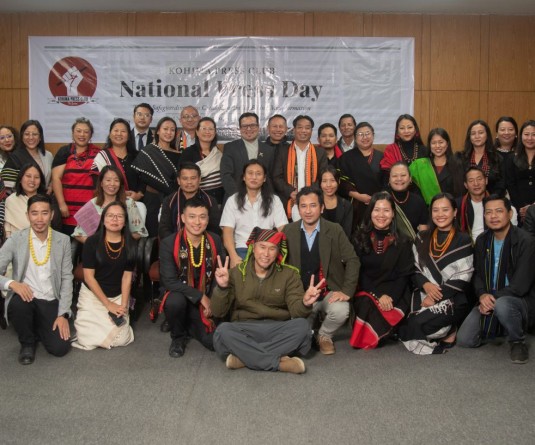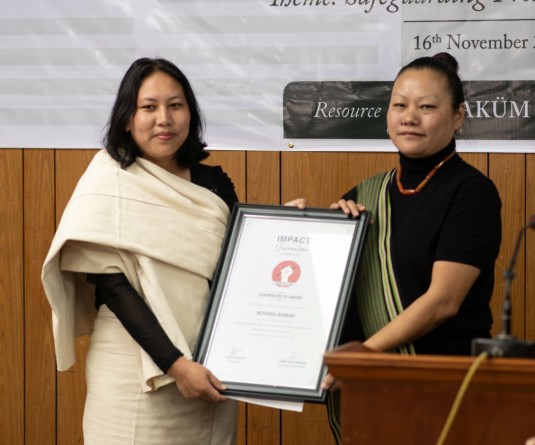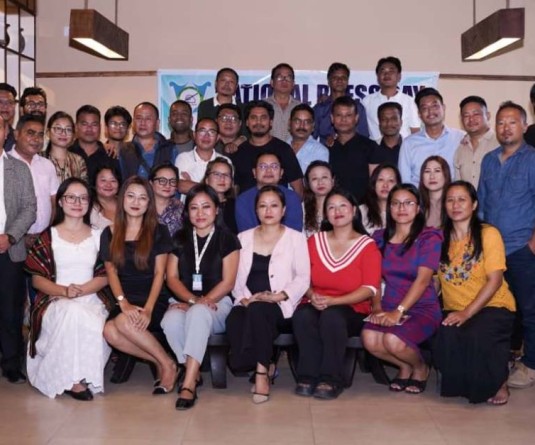
November 21, 2017  I am about to leave Haflong. But the apex civil bodies of Dima Hasao district (NC Hills) in Assam are about to start a silent rally; so I stay. Nobojit, a local Dimasa youth, picks me up on his scooty and takes me to Lal Field in the centre of town—“We are not against the Naga people, but we don’t want to lose our land…” Someone is speaking over a loud speaker. Rich yellow, red, green of the Dimasa traditional weaves are on women’s drapes and men’s scarves. There are sarees, faneks, mekhala, chador, shirts, jackets. On a sunburn autumn morning, every other person has a placard—a cardboard piece pitched on a vertically split bamboo stick. No land to Nagalim. Peace is all we want. We want togetherness not separation. My land is my birth right.
I am about to leave Haflong. But the apex civil bodies of Dima Hasao district (NC Hills) in Assam are about to start a silent rally; so I stay. Nobojit, a local Dimasa youth, picks me up on his scooty and takes me to Lal Field in the centre of town—“We are not against the Naga people, but we don’t want to lose our land…” Someone is speaking over a loud speaker. Rich yellow, red, green of the Dimasa traditional weaves are on women’s drapes and men’s scarves. There are sarees, faneks, mekhala, chador, shirts, jackets. On a sunburn autumn morning, every other person has a placard—a cardboard piece pitched on a vertically split bamboo stick. No land to Nagalim. Peace is all we want. We want togetherness not separation. My land is my birth right.  A larger banner appears and civil society leaders, a lone woman leader in their ranks, take form behind it—Protest Rally against ‘Inclusion of Dima Hasao District in NSCN (IM)’s Greater Nagalim Demand;’ Organized by All Apex Bodies Co-ordination Committee, Dima Hasao. The Dimasa Students’ Union, Haflong, welcomes me, the lone woman and ‘outside’ journalist, to the gathering and introduces me to their apex body leaders. If they are displeased that I am putting up with a friend in Lodiram, the largest Zeme Naga village in Haflong town, they hide their displeasure with slow, long, nods. The Naga apex bodies have barred Nagas from participating in the rally; some other tribe apex bodies have followed. Assam Police—menacing, mustachioed, goggled, some women—appear in red berets, bullet proof vests, bamboo stick or heavy armory in hand. They lead or accompany the procession from Lal Field via Council Rotary to the DC’s Residence gate. As I photograph the participants walking in ant-like discipline through town, they shoot me on their phones. My short range lens has fogged so I have to shoot long range; I make a run to keep well ahead of the procession. Tired and roasted in the sun, I take a break and join a young girl in full Dimasa gear from Mahur, town next door. She came early that morning to Haflong with other friends, packed in two Sumos. Her poster reads, “We want togetherness, not separation.” Togetherness with whom? Separation from whom? I ask. I don’t know, she says. Why are you here? I ask. She laughs. Our leaders told us, she says. What do you do? I am in second year B.Com. What do you want to do after graduating? I don’t know. Nothing much to do in Haflong. It has been 13 months since the employees of the Dima Hasao Autonomous District Council have been paid a salary. Maybe I will have to go outside. How many jobs will the government give anyway? You ask more to our leaders. It’s just that if we lose our land also, what will we have?
A larger banner appears and civil society leaders, a lone woman leader in their ranks, take form behind it—Protest Rally against ‘Inclusion of Dima Hasao District in NSCN (IM)’s Greater Nagalim Demand;’ Organized by All Apex Bodies Co-ordination Committee, Dima Hasao. The Dimasa Students’ Union, Haflong, welcomes me, the lone woman and ‘outside’ journalist, to the gathering and introduces me to their apex body leaders. If they are displeased that I am putting up with a friend in Lodiram, the largest Zeme Naga village in Haflong town, they hide their displeasure with slow, long, nods. The Naga apex bodies have barred Nagas from participating in the rally; some other tribe apex bodies have followed. Assam Police—menacing, mustachioed, goggled, some women—appear in red berets, bullet proof vests, bamboo stick or heavy armory in hand. They lead or accompany the procession from Lal Field via Council Rotary to the DC’s Residence gate. As I photograph the participants walking in ant-like discipline through town, they shoot me on their phones. My short range lens has fogged so I have to shoot long range; I make a run to keep well ahead of the procession. Tired and roasted in the sun, I take a break and join a young girl in full Dimasa gear from Mahur, town next door. She came early that morning to Haflong with other friends, packed in two Sumos. Her poster reads, “We want togetherness, not separation.” Togetherness with whom? Separation from whom? I ask. I don’t know, she says. Why are you here? I ask. She laughs. Our leaders told us, she says. What do you do? I am in second year B.Com. What do you want to do after graduating? I don’t know. Nothing much to do in Haflong. It has been 13 months since the employees of the Dima Hasao Autonomous District Council have been paid a salary. Maybe I will have to go outside. How many jobs will the government give anyway? You ask more to our leaders. It’s just that if we lose our land also, what will we have?  I find another woman with a banner that reads ‘No land to Nagalim.’ What is Nagalim? I ask. It is Nagaland but now they will extend boundary to encroach on our land. Aren’t there Nagas in Dima Hasao? I ask. There are but they want 60% of our land. This is not acceptable. What if they want only their land to join Nagalim? You ask our leaders. I break away, take some more photos; we reach the DC’s residence. A goggled-black-half-jacket-over-denims-and-shirt clad officer, messenger for the day, is waiting at the gate with heavy security around him. Three leaders read out the memorandum addressed to the Prime Minister of India on a microphone—make the Framework Agreement public, keep Dima Hasao district’s territorial integrity intact. While at it, please apply ‘course correction’ to another episode. Dimapur was the erstwhile capital of the former Dimasa kingdom and was annexed by the British East India Company; don’t add insult to injury by adjoining more territory to proposed Nagalim. The memorandum is received and signed by the Additional DC. Even before the ink has dried, a young man brings the memorandum to a clandestine commoner, bespectacled-mustachioed, standing in a corner of the street, ironically behind me. Turning away from the crowd, he takes a picture of the document on his phone and directs the young man to return the document to the authorities quickly. Deeds done, an officer of the State Intelligence Bureau creeps up on me; he shows me an ID just to be sure. Madam, who are you? Where are you from? Why are you here? Where are you putting up? Journalist; Dimapur; covering rally; Lodiram. “Ah, you see, main problem is Dimapur. They are not happy about that,” he says. He also says he is Hmar. Are your people supporting the rally? He looks me straight in the eye. “You know how it is Madam; here and in Manipur. We are minorities, what can we say?” Read the article about the rally here: http://morungexpress.com/no-land-nagalim-assam-hills-protest-secrecy-around-framework-agreement/
I find another woman with a banner that reads ‘No land to Nagalim.’ What is Nagalim? I ask. It is Nagaland but now they will extend boundary to encroach on our land. Aren’t there Nagas in Dima Hasao? I ask. There are but they want 60% of our land. This is not acceptable. What if they want only their land to join Nagalim? You ask our leaders. I break away, take some more photos; we reach the DC’s residence. A goggled-black-half-jacket-over-denims-and-shirt clad officer, messenger for the day, is waiting at the gate with heavy security around him. Three leaders read out the memorandum addressed to the Prime Minister of India on a microphone—make the Framework Agreement public, keep Dima Hasao district’s territorial integrity intact. While at it, please apply ‘course correction’ to another episode. Dimapur was the erstwhile capital of the former Dimasa kingdom and was annexed by the British East India Company; don’t add insult to injury by adjoining more territory to proposed Nagalim. The memorandum is received and signed by the Additional DC. Even before the ink has dried, a young man brings the memorandum to a clandestine commoner, bespectacled-mustachioed, standing in a corner of the street, ironically behind me. Turning away from the crowd, he takes a picture of the document on his phone and directs the young man to return the document to the authorities quickly. Deeds done, an officer of the State Intelligence Bureau creeps up on me; he shows me an ID just to be sure. Madam, who are you? Where are you from? Why are you here? Where are you putting up? Journalist; Dimapur; covering rally; Lodiram. “Ah, you see, main problem is Dimapur. They are not happy about that,” he says. He also says he is Hmar. Are your people supporting the rally? He looks me straight in the eye. “You know how it is Madam; here and in Manipur. We are minorities, what can we say?” Read the article about the rally here: http://morungexpress.com/no-land-nagalim-assam-hills-protest-secrecy-around-framework-agreement/






